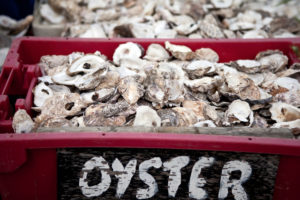When it comes to preserving the succulent taste of fresh seafood, one question often arises: Can you freeze oysters?
Yes you can freeze oysters, it’s essential to note that when they thaw, the texture of the meat tends to become softer, making them generally unsuitable for raw consumption.
Whether you’re a seafood enthusiast looking to extend the shelf life of your favorite bivalve delicacy or simply have a surplus of oysters on hand, understanding the ins and outs of freezing these ocean treasures can be invaluable.
In this article, we delve into the world of freezing oysters, exploring the dos and don’ts to help you make the most of this preservation method without compromising on flavor or quality.
Let’s shuck the myths and uncover the truth about freezing oysters.

Can Oysters be Frozen?
Oysters can be frozen, but there are some important considerations to keep in mind.
Freezing oysters can affect their texture and flavor, so it’s crucial to follow proper procedures to minimize these changes.
Freezing oysters is a viable option, but it’s essential to be aware of certain considerations.
When oysters are frozen and subsequently thawed, their texture tends to become softer, making them unsuitable for raw consumption.
However when used in cooked dishes, frozen oysters are perfectly acceptable.
Unlocking the Art of Freezing Oysters: Tips and Techniques
When it comes to preserving the ocean’s treasures for later culinary adventures, oysters often find their way into the spotlight.
Freezing oysters is a practical way to extend their shelf life, ensuring that you can enjoy their unique flavors and textures whenever you please.
In this guide, we’ll delve into the art of freezing oysters, exploring different methods to cater to your preferences and needs.
Explore the captivating world of oysters and uncover 10 compelling reasons to indulge in these oceanic delights
Freezing Whole Oysters: A Convenient Choice
Some oyster enthusiasts choose to freeze their oysters whole, preserving the full charm of these briny delights.
While it’s an option, it’s essential to consider that oysters tend to freeze more effectively when shucked first.
Shucking not only allows for better preservation but also makes them more versatile for various culinary creations.

Join us in a culinary exploration of the unique and delightful taste of oysters. Dive into the flavors here!
Shucking Oysters for Optimal Freezing
- Prepare the Oysters: Begin with fresh, high-quality oysters. Ensure they are free from any damage or spoilage. Cleaning and shucking are essential steps in the process.
- Shuck the Oysters: Gently shuck the oysters, taking care to remove them from their shells. Cleaning them thoroughly will rid them of any debris, grit, or shell fragments.
- Drain Excess Moisture: To prevent freezer burn, place the shucked oysters on a paper towel to remove excess moisture. This step is crucial for maintaining their quality.
- Portion and Package: Decide on the portion size that suits your needs. It’s recommended to portion them in a way that aligns with your intended use. Place the shucked oysters in airtight containers or vacuum-sealed bags.
- Label and Date: To keep track of freshness, label each container or bag with the date of freezing.
- Proper Freezing: Place the containers in the coldest part of your freezer, ensuring the temperature remains consistently below freezing (0°F or -18°C).
Thawing Frozen Oysters: A Delicate Process
When the time comes to use your frozen oysters, it’s crucial to thaw them safely:
- Slow Thawing: Thaw the oysters slowly in the refrigerator for several hours or overnight. Avoid quick thawing at room temperature, as this can lead to texture and flavor changes.
- Prompt Use: Once thawed, incorporate the oysters into your desired recipes immediately.
Preserving Frozen Oysters: Key Considerations
- While freezing oysters whole is an option, shucking them before freezing is generally more effective for preserving their quality.
- Frozen oysters are best suited for cooked dishes, as freezing can alter their texture, making them less suitable for raw consumption.
- With proper freezing and storage, oysters can remain safe to eat for several months, but it’s recommended to use them within 3-6 months for the best quality.
- Always avoid refreezing oysters, as it can compromise their safety and quality.

Oyster Freezing Tips
To ensure the best results when freezing oysters:
- Freeze Quickly: Oysters should be frozen rapidly at a temperature of 0°F or lower. This rapid freezing process minimizes the formation of larger ice crystals, which can otherwise cause tissue damage.
- Proper Packaging: It’s recommended to use freezer bags or plastic containers with tight-fitting lids for freezing oysters. Before sealing, ensure that the oysters are immersed in their liquor or water, and expel excess air from the containers to protect against freezer burn.
- Storage Conditions: Maintain the frozen oysters at a constant temperature of 0°F or lower to preserve their quality.
- Thawing: When you’re ready to use frozen oysters, always thaw them in the refrigerator. Allow at least 24 hours for complete thawing. Avoid thawing at room temperature or using other rapid thawing methods.
- Never Refreeze: Once oysters have been thawed, it’s essential never to refreeze them, as this can compromise their safety and quality.
While freezing oysters is a practical option, it’s important to follow these guidelines to ensure that the oysters maintain their quality and safety, particularly when used in cooked dishes.
Freezing oysters is an excellent way to enjoy these ocean gems whenever the mood strikes.

Embracing Convenience with Frozen Oysters
Freezing oysters is more than just a practical choice; it’s a culinary strategy that allows you to enjoy these treasures of the sea whenever inspiration strikes.
By shucking and freezing oysters, you not only extend their shelf life but also elevate your cooking repertoire. Their ability to enhance dishes like chowders, stews, and seafood pasta becomes an asset in your kitchen.
Moreover, the convenience of having frozen oysters on hand eliminates the need for last-minute grocery store runs.
Whether it’s a spontaneous gathering of friends or a cozy dinner for two, you can effortlessly incorporate the flavors of the ocean into your meals.
As you embark on your journey of freezing oysters, remember the importance of proper storage, thawing, and utilization.

Whether it’s a quick weeknight dinner or a special occasion, your frozen oysters are ready to transform your culinary creations into memorable experiences.
Freezing oysters is not just about preservation; it’s about embracing the convenience of having a culinary treasure trove in your freezer.
So, shuck, freeze, and savor the flavors of the sea on your terms, all while elevating your cooking game.
Your freezer holds the key to a world of delicious possibilities with these briny, delectable gems.

